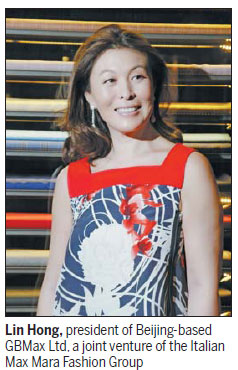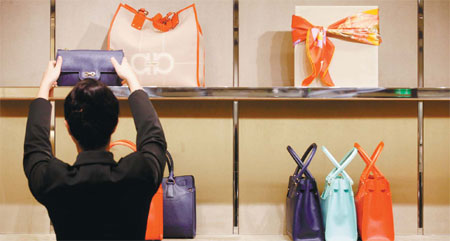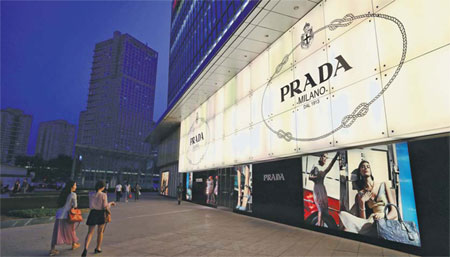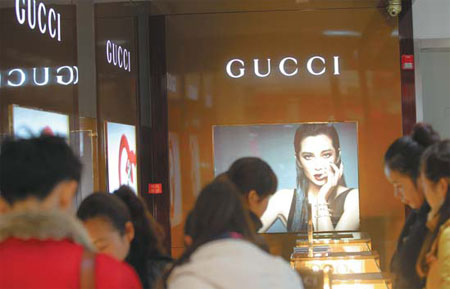China a la mode
Updated: 2013-05-31 08:56
By Yao Jing (China Daily)
|
|||||||||||
|
For many young Chinese shoppers, well-known Italian brands are still regarded as superior and are seen as a status symbol. Provided to China Daily |
|
The high cost of advertising and retailing make it harder for small brands to stand out in China. Provided to China Daily |
|
Gucci plans to slow its expansion in China this year. Provided to China Daily |
Ground down by a bleak economy at home, Italian brands are looking for relief from afar
In Italy, home of the world's most recognized fashion brands, including Gucci, Prada and Salvatore Ferragamo, the downturn in the fashion industry and the gloomy economy generally are pushing fashion houses to put more effort into emerging markets.
China, the world's largest luxury market, has naturally become the priority for these well-known brands as they try to make up for their losses at home and build their reputation among new customers.
Even though big names are busy increasing investment or adjusting strategies in an anemic market, their lesser-known smaller rivals are also pouring into China, hoping the country's well-heeled can offer them financial respite.
Corneliani, the high-end Italian menswear brand, opened its first fully owned flagship store in Shanghai in April, and its compatriot Damiani SpA, a jeweler, aims to have 12 stores in the country by the end of the year.
 |
Pucci, an Italian high-end female dress label, unveiled its first retail location in the Chinese mainland last year, and Alberta Ferretti, the Italian high-end fashion label, has opened the first store of its Philosophy brand in Hangzhou, Zhejiang province.
New entrants testing the market lag well behind their big rivals, many of whom have poured a great deal of money and effort into China over many years. Nevertheless, the arrival of the latecomers is stoking competition in the Chinese luxury market, one that has gone off the boil.
All the while, big names from Italy are gaining momentum. The fashion house Prada went public in Hong Kong with the largest IPO for the country in 2011. With the opening of its first store in Nanjing, Jiangsu province, in February, it now has 25 shops in China.
Salvatore Ferragamo says that in January it raised its stake in a joint venture with Imaginex of Hong Kong for distribution in China from 50 to 75 percent. It has about 100 sales points in China, and Asia accounted for more than one third of its total revenue last year.
The contrast with what the Italians are facing at home is stark. Sales of domestic brands seem to be in free fall, having dropped 20 percent last year and with predictions of a similar fall this year. Overall, fashion sales dropped 8 percent last year, Italy's fashion association says.
"The recession of the past few years, low consumer confidence, uncertainty about domestic politics and falling purchasing power continue to weigh on Italians' spending habits," says Lin Hong, president of GBMax Ltd of Beijing, a joint venture of the Italian Max Mara Fashion Group, which has opened 250 stores in the Chinese mainland for its seven brands.
The amount of red ink the Italian fashion entry has spilt at home has been kept down thanks to purchases by tourists, many of them Chinese.
|
||||
"Between 2008 and 2012 Chinese consumers nearly doubled their share of global spending from 14 percent to 27 percent."
Because of lower prices and the advantages of duty-free shopping, 60 percent of luxury spending by Chinese last year took place outside the country, Bain & Company says.
"On major fashion streets, such as Via Montenapoleone in Milan, close to 90 percent of sales are to foreign tourists and over half of them are Chinese," says Philip Guarino, co-founder of the consulting firm Emerging Market Luxury Advisors in Los Angeles.
But Chinese tourists gravitate to the larger, most well-known brands, experts say.
So smaller retailers have not benefited much from Chinese customers' overseas shopping. And they do not want to waste time anymore, but directly enter into the market to reach consumers.
However, breaking into China is no cakewalk, and any retailer with ambitions of doing well needs to do extensive research beforehand to identify the right opportunities and the right places for doing business.
Customers who often go overseas may know of these smaller brands, but compared with big names the number of customers is minuscule.
Related Stories
Dirk gets match-fit for Eastern league 2013-05-31 08:56
Today's Top News
List of approved GM food clarified
ID checks for express deliveries in Guangdong
Govt to expand elderly care
University asks freshmen to sign suicide disclaimer
Tibet gears up for new climbing season
Media asked to promote Sino-Indian ties
Shots fired at Washington Navy Yard
Minimum growth rate set at 7%
Hot Topics
Lunar probe , China growth forecasts, Emission rules get tougher, China seen through 'colored lens', International board,
Editor's Picks

|

|

|

|

|

|









